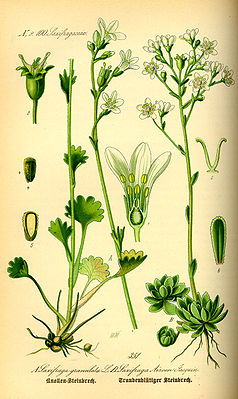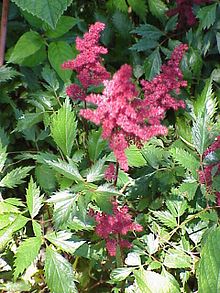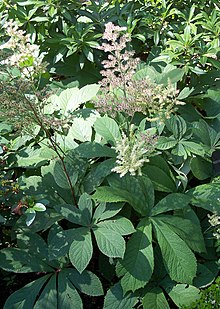Saxifrage
| Saxifrage | ||||||||||||
|---|---|---|---|---|---|---|---|---|---|---|---|---|

Two saxifrage species ( Saxifraga ), illustration |
||||||||||||
| Systematics | ||||||||||||
|
||||||||||||
| Scientific name | ||||||||||||
| Saxifragaceae | ||||||||||||
| Yuss. |
The Saxifragaceae (Saxifragaceae) are a family of plants in the order of the saxifrage-like (Saxifragales) within the flowering plant (Magnoliopsida).
description
Vegetative characteristics
They are annual, biennial or herbaceous plants . They can develop rhizomes or stolons. Some species are succulent . CAM has been detected in some species.
The leaves are mostly alternate, with Chrysosplenium , Lithophragma , Mitella , some Saxifraga arranged opposite, mostly in basal rosettes or sometimes distributed on the stem. There may be a petiole. The leaf blade is mostly simple or rarely composed in Astilbe , Lithophragma , Tiarella . The leaf margin is smooth, creased, serrate, toothed, ciliate or glandular-ciliate. Stipules are present or absent.
Generative characteristics
The flowers stand individually or in pairs up to 300 (rarely up to over 1000) in terminal, simple or compound, mostly racemose , paniculate or zymose in inflorescences . There may be bracts .
The five-fold and mostly radially symmetrical flowers are hermaphroditic or, rarely, unisexual in some astilbe and saxifraga species. Many Saxifraga species have zygomorphic flowers. The flower cup (hypanthium) is free or more or less fused with the ovary. There are usually five (four to six) free sepals and usually five (four to six) free petals , which can be lobed or unlobed. Mostly there are one or two circles with five fertile stamens each, it can be two to ten in total. But with the genus Milzkraut ( Chrysosplenium ) the flowers are four-fold with only one bloom circle and two circles with four stamens each. The usually two or less often three upper to lower carpels are fused below and free above. The usually three, rarely two styles are free and shorter than the ovary. Most of the Saxifragaceae are homostyled, except for the heterostyled Jepsonia .
The flower formula is: or or
The capsule fruits or follicles contain two to two hundred seeds. The tiny to small seeds contain oily endosperm and a small, straight embryo.





Systematics and distribution
The family of the Saxifragaceae was set up in 1789 under the name "Saxifragae" by Antoine Laurent de Jussieu in Genera Plantarum , p. 308. The type genus is Saxifraga L. Molecular genetic studies have led to the fact that some genera, which, for example, were classified here by Soltis & Soltis 1997, are now classified in other families. The research results of the last few years also led to some genres being divided, expanded or reorganized. This has not yet been concluded and some of it is still under discussion.
The species of the Saxifragaceae family occur in temperate climates , especially in the northern hemisphere . In North America there are 23 genera with around 158 species. In Central Europe this family is through the genres Chrysosplenium ( Chrysosplenium ) and saxifrage ( Saxifraga represented).
The Saxifragaceae family contains 33 to 38 genera with around 540 to 600 species:
- Prachtspieren ( Astilbe Buch.-Ham. Ex G.Don ): The approximately 18 species are common in East Asia and North America.
-
Astilboides (Hemsl.) Engl .: It contains only one species:
- Tafelblatt ( Astilboides tabularis (Hemsl.) Engl. ): It occurs in northern China.
-
Bensoniella C.V. Morton : It contains only one species:
- Bensoniella oregona (Abrams & Bacig.) CVMorton : in North America
- Bergenien ( Bergenia Moench ): With about ten kinds in East Asia
- Bolandra A.Gray : With only two species in North America
- Boykinia Nutt. : With about nine species in East Asia and North America
- Spleen herbs ( Chrysosplenium L. ): With around 55 to 65 species, most of which occur in Europe, Northeast Asia and North America and only a few species in North Africa and temperate South America
-
Conimitella Rydb. : It contains only one type:
- Conimitella williamsii (Rydb.) DCEaton : in North America
-
Darmera Voss : With only one species in California and Oregon:
- Shield leaf , umbrella saxifrage , Indian rhubarb , umbrella plant ( Darmera peltata (Torr. Ex Benth.) Voss , Syn .: Saxifraga peltata Torr. , Peltiphyllum peltatum Engl. )
-
Elmera Rydb. : It contains only one type:
- Elmera racemosa (S.Wats.) Rydb. : in British Columbia, Oregon and Washington
- Purple bell ( Heuchera L. ): With about 35 to 50 species in North America
- × Heucherella Wehrh. (= Heuchera × Tiarella )
- Jepsonia Small : With only about three species in California
-
Leptarrhena R.Br. : It contains only one type:
- Leptarrhena pyrolifolia (D.Don) Ser. : in western North America
- Lithophragma (Nutt.) Torr. & A.Gray : With about twelve species in western North America
- Micranthes Haworth : With 68-93 species (by most authors to the genus saxifrage ( Saxifraga provided))
- Mitella L .: With about 20 species in western North America and in East Asia
-
Mukdenia Koidz. : With only one (or two) species in Northern China, Manchuria and Korea, including:
- Maple leaf ( Mukdenia rossii (Oliv.) Koidz. )
-
Oresitrophe Bunge : It contains only one type:
- Oresitrophe rupifraga Bunge : in northeast China
- Peltoboykinia ( Engl. ) H. Hara : With only two kinds in Japan and China
- Record sheets ( Rodgersia A.Gray ): With about five kinds in Nepal and in East Asia
- Saxifrage ( Saxifraga L. ): with about 370 to 450 species.
-
Saxifragella Engl .: It contains only one species:
- Saxifragella bicuspidata (Hook. F.) Engl .: In Antarctic South America
-
Saxifragodes D.M.Moore : It contains only one species:
- Saxifragodes albowiana (Kurtz) DMMoore : Tierra del Fuego
-
Saxifragopsis Small : It contains only one species:
- Saxifragopsis fragarioides (Greene) Small : in California
- Suksdorfia A.Gray : With three kinds in western North America
- Sullivantia Torr. & A.Gray : With about five species in the US
-
Tanakaea Franch. & Sav. : It contains only one type:
- Tanakaea radicans Franch. & Sav. : in East Asia
-
Tellima R.Br. : It contains only one type:
- False mandrake root ( Tellima grandiflora R.Br. ): in western North America
- Foam flowers ( Tiarella L. ): With six kinds in North America and East Asia
-
Tolmiea Torr. & A.Gray : It contains only one type:
- Hen with chicks ( Tolmiea menziesii Torr. & A.Gray ): in western North America.
swell
- The Saxifragaceae family on the AP website . (Sections Description and Systematics)
- The family at DELTA. (Section description)
literature
- Elizabeth Fortson Wells, Patrick E. Elvander: Saxifragaceae in the Flora of North America , Volume 8, 2009, pp. 43–230: the same text online as the printed work. (Sections Description and Systematics)
- David Allardice Webb, Richard J. Gornall: Saxifrages of Europe, with notes on African, American and some Asiatic species. London 1989.
Individual evidence
- ↑ Douglas E. Soltis & Pamela S. Soltis: Phylogenetic Relationships in Saxifragaceae Sensu Lato: A Comparison of Topologies Based on 18S rDNA and rbcL Sequences , in American Journal of Botany , Volume 84, No. 4, 1997, pp. 504-522.
- ↑ Saxifragaceae in the Germplasm Resources Information Network (GRIN), USDA , ARS , National Genetic Resources Program. National Germplasm Resources Laboratory, Beltsville, Maryland.
Web links
- The Saxifrage Society. (English)
- Jin-tang Pan, Cuizhi Gu, Shumei Huang, Chao-fen Wei, Shu-ying Jin, Lingdi Lu, Shinobu Akiyama, Crinan Alexander, Bruce Bartholomew, James Cullen, Richard J. Gornall, Ulla-Maj Hultgård, Hideaki Ohba, Douglas E. Soltis: Saxifragaceae in the Flora of China , Volume 8, 2001, p. 269 ff: Online. (still with genera that belong to other families today)


